The big day. Arriving in Santiago de Compostela. Enter the Cathedral. See the Botafumeiro fly. Hug the Apostle St. James.
The route to Santiago is not too long, but still has some steep slopes. The sky had been overcast the night before and it was expected to rain heavily during the day. Which is no surprise, after all this is Galicia, and Santiago de Compostela is the rainiest city in Spain on average (my mother told me this from playing Trivial). So if you come to the Camino, you’re likely to get wet -more than once-.
With the rain, who knows how long it would take to get to the Cathedral of Santiago. The pilgrim’s mass is at 12:00, but you have to get there early to get in line to get in. The doors close when the capacity of the Cathedral – which is quite large – is full. So I had to arrive reasonably early and also be prepared for any mishap that might delay me. At 6 a.m. on the ground floor, then.
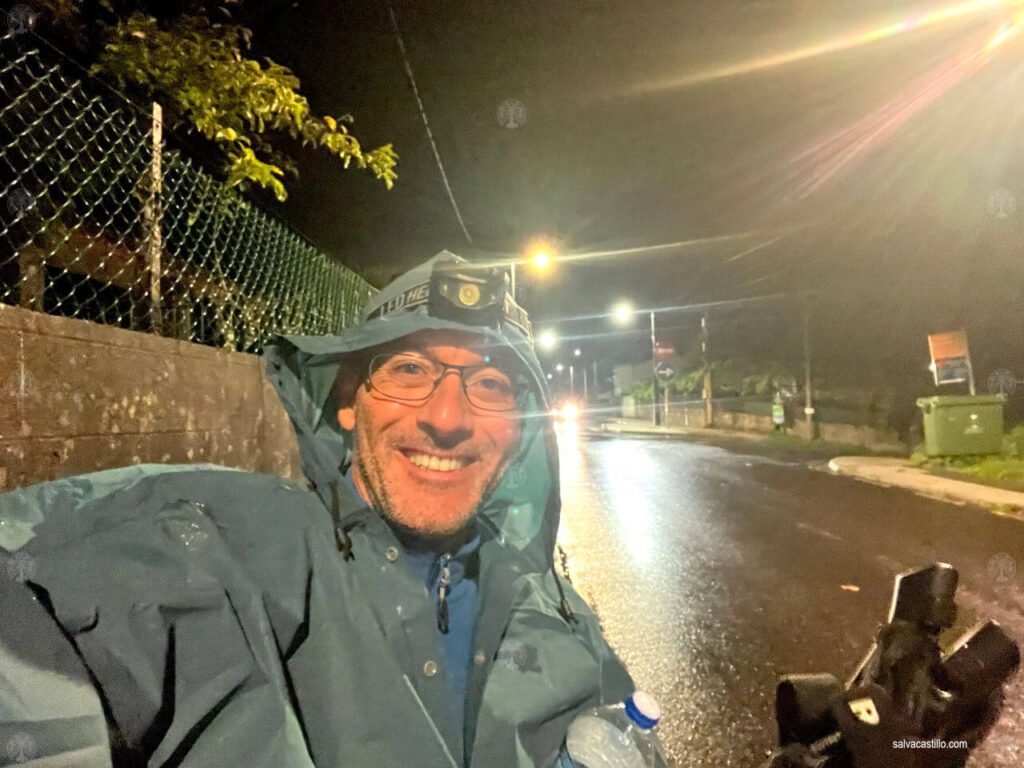
The start in O Pedrouzo was simply spectacular: night closed in, and groups of pilgrims marching at a very good pace in the dark, with their headlamps on. The picture was beautiful: spaced beams of bright light that broke the night black and illuminated the trunks and tops of the trees as they passed. The snake of light moved in the distance negotiating the curves of the road.
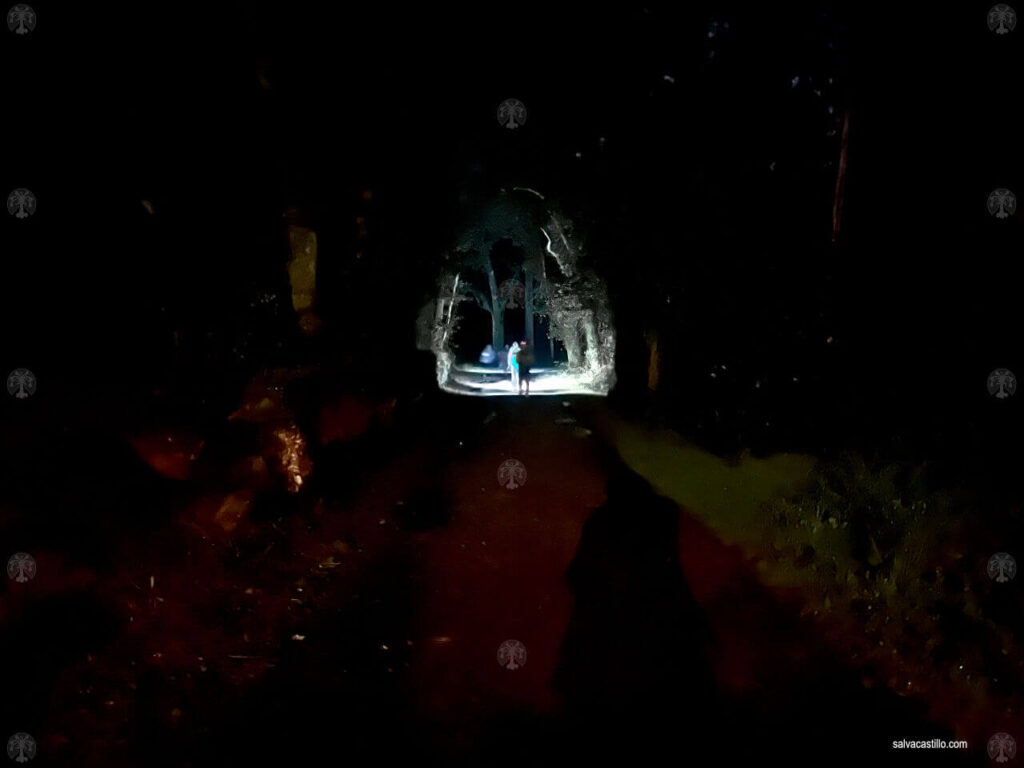
During the day, the constant hustle and bustle of the myriad pilgrims must cause the wild animals to move away from the route. But at night, considering that for quite a while I was walking alone with the nearest group of light several hundred meters in front of me, animals are more likely to approach.

Still dark and raining, I engaged in a -very brief- conversation with a girl who came with a brisk pace and helped me to orient myself at a poorly marked road junction. She had been walking for 32 days. She slowed down to keep pace with me as we faced one of the steep slopes at the beginning. I thanked her and released her so she could keep up. Up ahead she was resting at a bend in the trail while petting a cat. Her Camino experience must have been exceptional.

Beware the fierce westies.

The Knights Templar (of the “Order of the Poor Knights of Christ and the Temple of Solomon”), in charge of security on the routes to Jerusalem, were for a time also in charge of the protection of pilgrims. The king of Asturias, Alfonso II El Casto, was the one who, in the 12th century, initiated and promoted the cult of the Apostle James and the pilgrimage to the place of his tomb, Santiago de Compostela. The pilgrims increased in number and infrastructures began to be built to accommodate and protect them. Along the way there are several buildings attributed to the Templars.

I also did this last stage carrying my backpack on my back. I think it was the appropriate way to finish the trail. I used 95% of what I had with me, and I didn’t really miss anything. It was pretty much spot on. Next time I will reduce the size of the containers considerably.
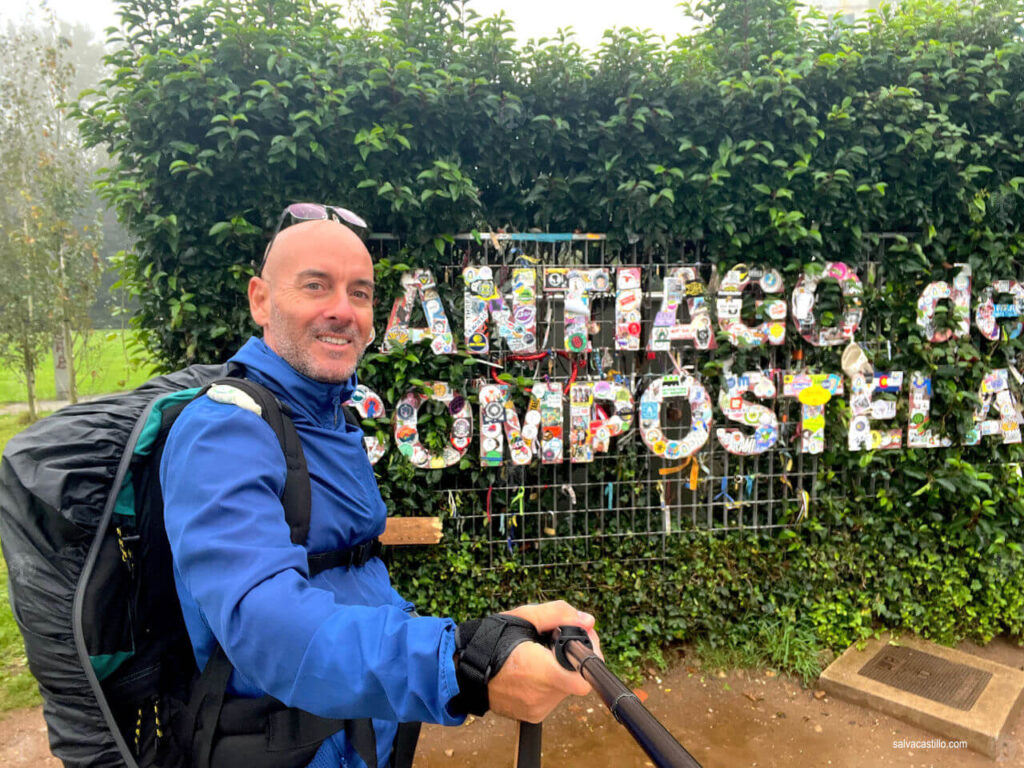
As I go deeper into the old town of Santiago, the river of pilgrims becomes more excited. It’s a beautiful moment when you arrive with the sound of bagpipes at the Obradoiro square. I didn’t experience that mystical feeling or the exacerbated joy that some describe; simply the satisfaction of having done something well – mind you, that’s no small thing. One does get infected by the joy of the pilgrims who are gradually arriving to complete their Camino. You can see scenes where you can guess that the pilgrims greeting and congratulating each other have coincided at some point earlier in the Camino. It is a square brimming with satisfaction. Some pilgrims cry. The mist covered the Cathedral. How bucolic is that.
My statement having just finished Santiago’s Way is written in Galaecian, which is the official language of the region of Galicia: E ao final, é unha gran aventura onde superamos retos físicos, pero os retos espirituais que nos fan crecer como persoa teñen aínda máis impacto. Esa é a esencia do Camiño. // *At the end, it is a great adventure where we overcome physical challenges, but the spiritual challenges that we overcome have far more greater impact as they make us grow up as a person*
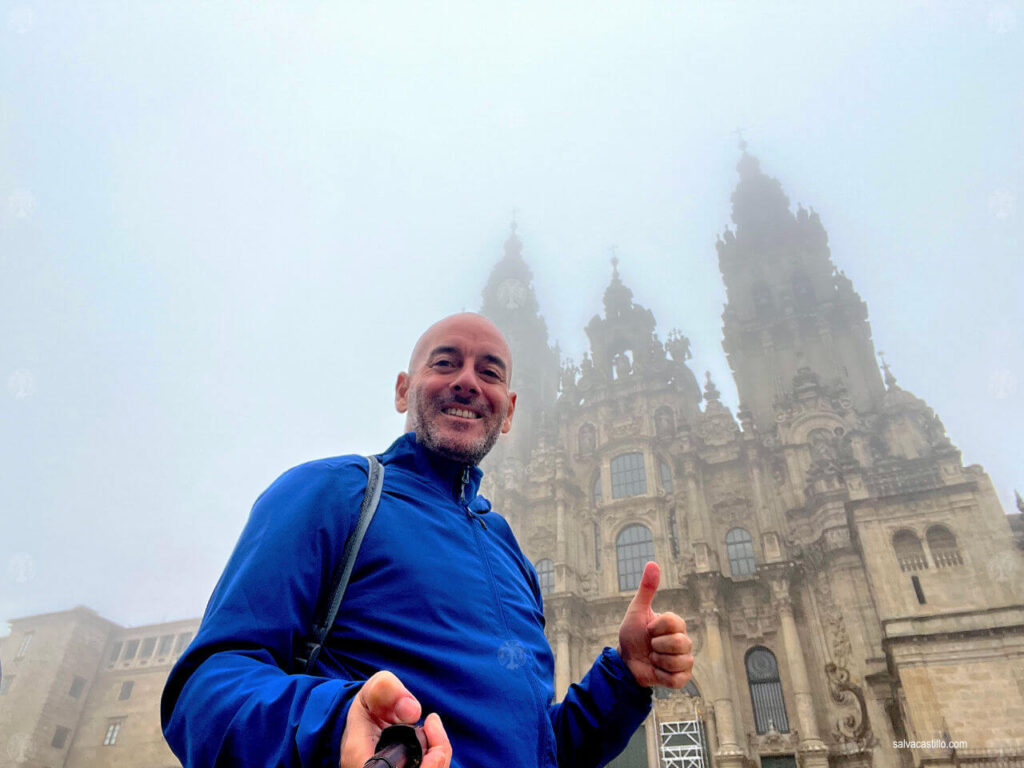
After a long line (~30 min.) I was able to access the inside of the Cathedral. It was packed, so they closed the doors shortly after I entered. Something I was unaware of is that the Botafumeiro (“Turibulum Magnum”) is not used every day. I took it for granted that I was going to see it. But it is only used in certain solemnities or when someone pays to fly it. That is, there’s a good chance that if you go to a pilgrim mass, you won’t see it work. In my case I was, again, very fortunate: an organization from Los Angeles that was finishing the Camino that day -I don’t remember which one- covered the cost and all of us present were able to enjoy it.
The Botafumeiro is made of silver plated brass, measures 1.50 m. and weighs 65 kg. empty. The rope measures 65 m. (in total) and is operated by 8 people (“tiraboleiros”) who hang from it at the same time pulling at the right moment to increase the angle of flight of the Botafumeiro. It can climb more than 20 meters vertically and moves at about 70 Km/h. The flight is short, about 90 seconds in total.
The magnificent organ sounded as it flew and the smell of incense it gave off, the “whooosh” that sounded with each lunge… an impressive experience.

At the conclusion of mass, it’s time to go pay respects to the Apostle St. James. The steps leading up to the vaulted room that houses his statue behind the Cathedral’s altar are worn by the plethora of pilgrims who have trodden them over the centuries.

Although I am not a person of religious convictions, as I embraced the Apostle I felt comforted and came out saying “Tate” (In some regions in Spain, “Tate” is an informal, familiar way to call a sibling of yours). I don’t have much idea why I said that, nor where that familiarity with the Mister Apostle comes from, but that’s how it was. From now on it’s Tate James for me. 🤷🏻
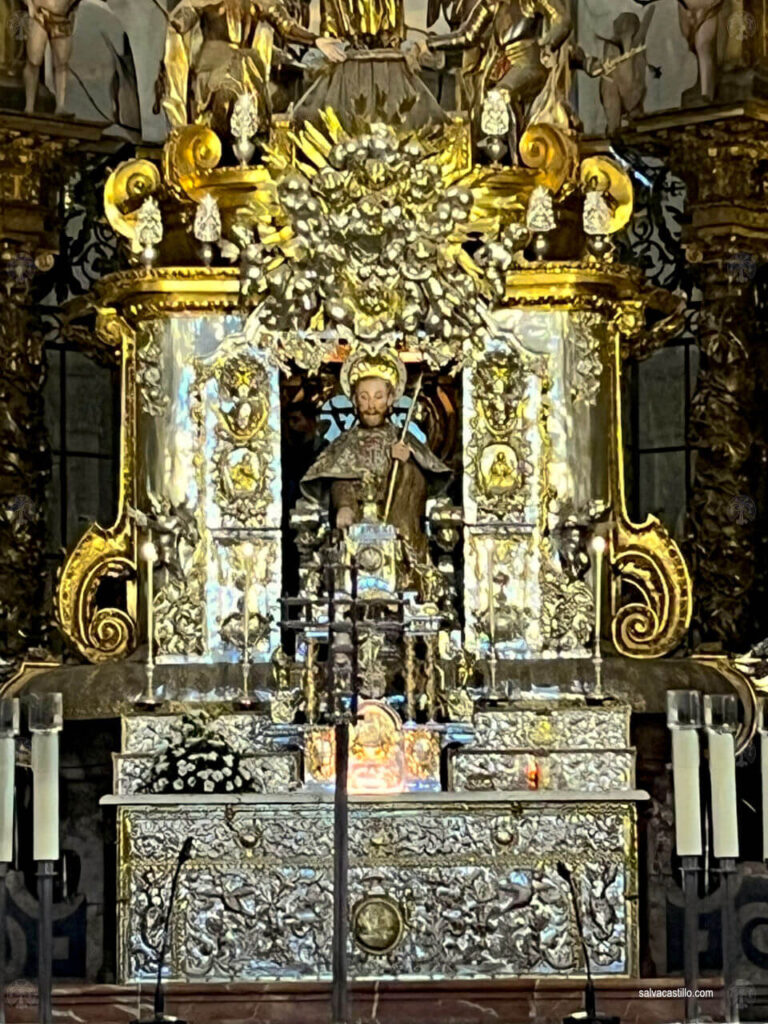
The Cross of Santiago flanks the underground tomb located below the statue of the Apostle.

The altar of the Cathedral of Santiago is profusely carved and you can see how pilgrims constantly pass by to embrace the Apostle.
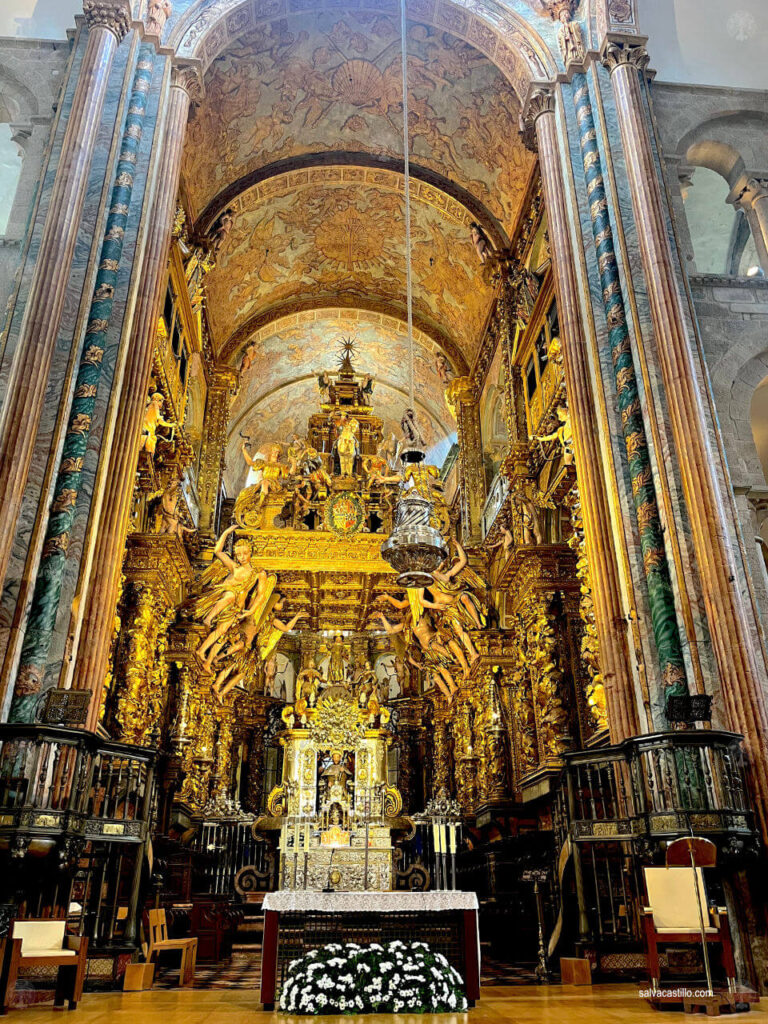
The support mechanism of the Botafumeiro is a rotating pulley anchored to the four pillars that support the main dome.
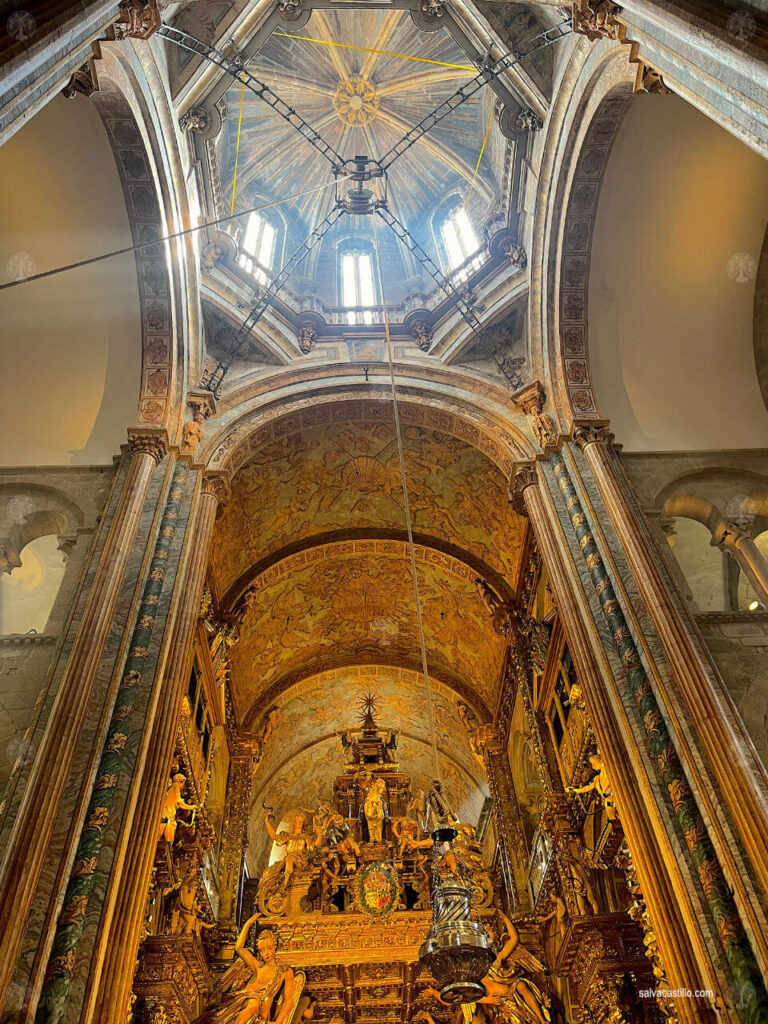
The Cathedral’s organ is of overwhelming beauty. Built in 1527, it has been successively enriched over the centuries to form a unique Baroque piece whose pipes soar over the main nave.

Definitely the Cathedral of Santiago is a marvel, one of the most beautiful I have visited, and I have already visited a few in Europe and America.

The big day. Arriving in Santiago de Compostela. Enter the Cathedral. See the Botafumeiro fly. Hug the Apostle St. James.
The route to Santiago is not too long, but still has some steep slopes. The sky had been overcast the night before and it was expected to rain heavily during the day. Which is no surprise, after all this is Galicia, and Santiago de Compostela is the rainiest city in Spain on average (my mother told me this from playing Trivial). So if you come to the Camino, you’re likely to get wet -more than once-.
With the rain, who knows how long it would take to get to the Cathedral of Santiago. The pilgrim’s mass is at 12:00, but you have to get there early to get in line to get in. The doors close when the capacity of the Cathedral – which is quite large – is full. So I had to arrive reasonably early and also be prepared for any mishap that might delay me. At 6 a.m. on the ground floor, then.

The start in O Pedrouzo was simply spectacular: night closed in, and groups of pilgrims marching at a very good pace in the dark, with their headlamps on. The picture was beautiful: spaced beams of bright light that broke the night black and illuminated the trunks and tops of the trees as they passed. The snake of light moved in the distance negotiating the curves of the road.

During the day, the constant hustle and bustle of the myriad pilgrims must cause the wild animals to move away from the route. But at night, considering that for quite a while I was walking alone with the nearest group of light several hundred meters in front of me, animals are more likely to approach.

Still dark and raining, I engaged in a -very brief- conversation with a girl who came with a brisk pace and helped me to orient myself at a poorly marked road junction. She had been walking for 32 days. She slowed down to keep pace with me as we faced one of the steep slopes at the beginning. I thanked her and released her so she could keep up. Up ahead she was resting at a bend in the trail while petting a cat. Her Camino experience must have been exceptional.

Beware the fierce westies.

The Knights Templar (of the “Order of the Poor Knights of Christ and the Temple of Solomon”), in charge of security on the routes to Jerusalem, were for a time also in charge of the protection of pilgrims. The king of Asturias, Alfonso II El Casto, was the one who, in the 12th century, initiated and promoted the cult of the Apostle James and the pilgrimage to the place of his tomb, Santiago de Compostela. The pilgrims increased in number and infrastructures began to be built to accommodate and protect them. Along the way there are several buildings attributed to the Templars.

I also did this last stage carrying my backpack on my back. I think it was the appropriate way to finish the trail. I used 95% of what I had with me, and I didn’t really miss anything. It was pretty much spot on. Next time I will reduce the size of the containers considerably.

As I go deeper into the old town of Santiago, the river of pilgrims becomes more excited. It’s a beautiful moment when you arrive with the sound of bagpipes at the Obradoiro square. I didn’t experience that mystical feeling or the exacerbated joy that some describe; simply the satisfaction of having done something well – mind you, that’s no small thing. One does get infected by the joy of the pilgrims who are gradually arriving to complete their Camino. You can see scenes where you can guess that the pilgrims greeting and congratulating each other have coincided at some point earlier in the Camino. It is a square brimming with satisfaction. Some pilgrims cry. The mist covered the Cathedral. How bucolic is that.
My statement having just finished Santiago’s Way is written in Galaecian, which is the official language of the region of Galicia: E ao final, é unha gran aventura onde superamos retos físicos, pero os retos espirituais que nos fan crecer como persoa teñen aínda máis impacto. Esa é a esencia do Camiño. // *At the end, it is a great adventure where we overcome physical challenges, but the spiritual challenges that we overcome have far more greater impact as they make us grow up as a person*

After a long line (~30 min.) I was able to access the inside of the Cathedral. It was packed, so they closed the doors shortly after I entered. Something I was unaware of is that the Botafumeiro (“Turibulum Magnum”) is not used every day. I took it for granted that I was going to see it. But it is only used in certain solemnities or when someone pays to fly it. That is, there’s a good chance that if you go to a pilgrim mass, you won’t see it work. In my case I was, again, very fortunate: an organization from Los Angeles that was finishing the Camino that day -I don’t remember which one- covered the cost and all of us present were able to enjoy it.
The Botafumeiro is made of silver plated brass, measures 1.50 m. and weighs 65 kg. empty. The rope measures 65 m. (in total) and is operated by 8 people (“tiraboleiros”) who hang from it at the same time pulling at the right moment to increase the angle of flight of the Botafumeiro. It can climb more than 20 meters vertically and moves at about 70 Km/h. The flight is short, about 90 seconds in total.
The magnificent organ sounded as it flew and the smell of incense it gave off, the “whooosh” that sounded with each lunge… an impressive experience.

At the conclusion of mass, it’s time to go pay respects to the Apostle St. James. The steps leading up to the vaulted room that houses his statue behind the Cathedral’s altar are worn by the plethora of pilgrims who have trodden them over the centuries.

Although I am not a person of religious convictions, as I embraced the Apostle I felt comforted and came out saying “Tate” (In some regions in Spain, “Tate” is an informal, familiar way to call a sibling of yours). I don’t have much idea why I said that, nor where that familiarity with the Mister Apostle comes from, but that’s how it was. From now on it’s Tate James for me. 🤷🏻

The Cross of Santiago flanks the underground tomb located below the statue of the Apostle.

The altar of the Cathedral of Santiago is profusely carved and you can see how pilgrims constantly pass by to embrace the Apostle.

The support mechanism of the Botafumeiro is a rotating pulley anchored to the four pillars that support the main dome.

The Cathedral’s organ is of overwhelming beauty. Built in 1527, it has been successively enriched over the centuries to form a unique Baroque piece whose pipes soar over the main nave.

Definitely the Cathedral of Santiago is a marvel, one of the most beautiful I have visited, and I have already visited a few in Europe and America.

The big day. Arriving in Santiago de Compostela. Enter the Cathedral. See the Botafumeiro fly. Hug the Apostle St. James.
The route to Santiago is not too long, but still has some steep slopes. The sky had been overcast the night before and it was expected to rain heavily during the day. Which is no surprise, after all this is Galicia, and Santiago de Compostela is the rainiest city in Spain on average (my mother told me this from playing Trivial). So if you come to the Camino, you’re likely to get wet -more than once-.
With the rain, who knows how long it would take to get to the Cathedral of Santiago. The pilgrim’s mass is at 12:00, but you have to get there early to get in line to get in. The doors close when the capacity of the Cathedral – which is quite large – is full. So I had to arrive reasonably early and also be prepared for any mishap that might delay me. At 6 a.m. on the ground floor, then.

The start in O Pedrouzo was simply spectacular: night closed in, and groups of pilgrims marching at a very good pace in the dark, with their headlamps on. The picture was beautiful: spaced beams of bright light that broke the night black and illuminated the trunks and tops of the trees as they passed. The snake of light moved in the distance negotiating the curves of the road.

During the day, the constant hustle and bustle of the myriad pilgrims must cause the wild animals to move away from the route. But at night, considering that for quite a while I was walking alone with the nearest group of light several hundred meters in front of me, animals are more likely to approach.

Still dark and raining, I engaged in a -very brief- conversation with a girl who came with a brisk pace and helped me to orient myself at a poorly marked road junction. She had been walking for 32 days. She slowed down to keep pace with me as we faced one of the steep slopes at the beginning. I thanked her and released her so she could keep up. Up ahead she was resting at a bend in the trail while petting a cat. Her Camino experience must have been exceptional.

Beware the fierce westies.

The Knights Templar (of the “Order of the Poor Knights of Christ and the Temple of Solomon”), in charge of security on the routes to Jerusalem, were for a time also in charge of the protection of pilgrims. The king of Asturias, Alfonso II El Casto, was the one who, in the 12th century, initiated and promoted the cult of the Apostle James and the pilgrimage to the place of his tomb, Santiago de Compostela. The pilgrims increased in number and infrastructures began to be built to accommodate and protect them. Along the way there are several buildings attributed to the Templars.

I also did this last stage carrying my backpack on my back. I think it was the appropriate way to finish the trail. I used 95% of what I had with me, and I didn’t really miss anything. It was pretty much spot on. Next time I will reduce the size of the containers considerably.

As I go deeper into the old town of Santiago, the river of pilgrims becomes more excited. It’s a beautiful moment when you arrive with the sound of bagpipes at the Obradoiro square. I didn’t experience that mystical feeling or the exacerbated joy that some describe; simply the satisfaction of having done something well – mind you, that’s no small thing. One does get infected by the joy of the pilgrims who are gradually arriving to complete their Camino. You can see scenes where you can guess that the pilgrims greeting and congratulating each other have coincided at some point earlier in the Camino. It is a square brimming with satisfaction. Some pilgrims cry. The mist covered the Cathedral. How bucolic is that.
My statement having just finished Santiago’s Way is written in Galaecian, which is the official language of the region of Galicia: E ao final, é unha gran aventura onde superamos retos físicos, pero os retos espirituais que nos fan crecer como persoa teñen aínda máis impacto. Esa é a esencia do Camiño. // *At the end, it is a great adventure where we overcome physical challenges, but the spiritual challenges that we overcome have far more greater impact as they make us grow up as a person*

After a long line (~30 min.) I was able to access the inside of the Cathedral. It was packed, so they closed the doors shortly after I entered. Something I was unaware of is that the Botafumeiro (“Turibulum Magnum”) is not used every day. I took it for granted that I was going to see it. But it is only used in certain solemnities or when someone pays to fly it. That is, there’s a good chance that if you go to a pilgrim mass, you won’t see it work. In my case I was, again, very fortunate: an organization from Los Angeles that was finishing the Camino that day -I don’t remember which one- covered the cost and all of us present were able to enjoy it.
The Botafumeiro is made of silver plated brass, measures 1.50 m. and weighs 65 kg. empty. The rope measures 65 m. (in total) and is operated by 8 people (“tiraboleiros”) who hang from it at the same time pulling at the right moment to increase the angle of flight of the Botafumeiro. It can climb more than 20 meters vertically and moves at about 70 Km/h. The flight is short, about 90 seconds in total.
The magnificent organ sounded as it flew and the smell of incense it gave off, the “whooosh” that sounded with each lunge… an impressive experience.

At the conclusion of mass, it’s time to go pay respects to the Apostle St. James. The steps leading up to the vaulted room that houses his statue behind the Cathedral’s altar are worn by the plethora of pilgrims who have trodden them over the centuries.

Although I am not a person of religious convictions, as I embraced the Apostle I felt comforted and came out saying “Tate” (In some regions in Spain, “Tate” is an informal, familiar way to call a sibling of yours). I don’t have much idea why I said that, nor where that familiarity with the Mister Apostle comes from, but that’s how it was. From now on it’s Tate James for me. 🤷🏻

The Cross of Santiago flanks the underground tomb located below the statue of the Apostle.

The altar of the Cathedral of Santiago is profusely carved and you can see how pilgrims constantly pass by to embrace the Apostle.

The support mechanism of the Botafumeiro is a rotating pulley anchored to the four pillars that support the main dome.

The Cathedral’s organ is of overwhelming beauty. Built in 1527, it has been successively enriched over the centuries to form a unique Baroque piece whose pipes soar over the main nave.

Definitely the Cathedral of Santiago is a marvel, one of the most beautiful I have visited, and I have already visited a few in Europe and America.
